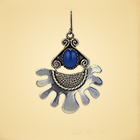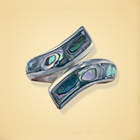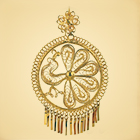For thousands of years, complex civilizations flourished,
in the land we call Mexico.



Due to fluctuations in the silver market, we are not offering any specials at this time.
AXCO, an old silver mining town 111 miles southwest of Mexico City in the state of Guerrero, is considered to be the jewelry center of Mexico. At 6,000 feet in elevation, hundreds of silver shops line the steep hillsde town where narrow cobblestone streets wind and VW Beetle taxis chug up and down. The federal government has declared the city a national historical monument and enacted laws to preserve Taxco's colonial style architecture and heritage. Although the presence of silver is overwhelming and much of it common, there are still a few of the old artisans working in beautiful Pre-Hispanic designs. Taxco is like an anthill with silver commerce its fuel, but it is also a beautifull town of entirely
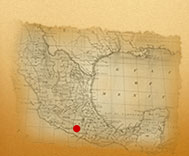
white buildings with red tile roofs and the lovely Santa Prisca church, undoubtedly one of Mexico's finest.
exico City, elevation 7,240 feet, is a fabulous capital city full of vitality, romance, art and history. It is also horribly polluted and has many poor and homeless citizens. In short, it is world's largest city and provides both the best and the worst any city has to offer, but on a grander scale. The Aztecs settled here in A.D. 1300, building their city on an island in the middle of Lake Texcoco. The lake dried up and mostly disappeared as did this city of 300,000 inhabitants. The Spanish conquered the Aztecs and made the city their capital. The city is still sinking into the lake at a rate of about an inch per year.
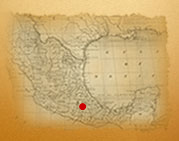
UANAJUATO, capital of the state of the same name, is a city built in a most improbable location. It is perched on the steep slopes of a ravine with narrow streets that twist around the hillsides and down into a series of tunnels- all because of the impossibly rich deposits of gold and silver found here by the Spaniards in 1559. Altought the city at one time provided a third of the entire world's silver supply, there is only one type of traditional jewelry found here, and very few remaining artisans trained in its craft. What does remain are the beautifull ornate 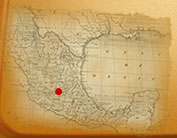 churches and theater built by the Spanish.
churches and theater built by the Spanish.
an Miguel de Allende is situated 180 miles northwest of Mexico City in the state of Guanajuato.
Like Taxco, it has been declared a national monument. It is a beautiful town that has retianed its colonial heritage in spite of the sizeable American colony found here. But, due in large part to that colony, San Miguel is an international city drawing tourists from around the world to its fine restaurants, hotels and shops. Handicrafts and good food abound in one of Mexico's prettiest cities.
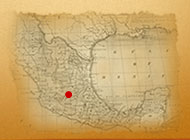
anta Clara del Cobre, 20 miles south of Patzcuaro, was a copper-mining center since pre-Hispanic times. The mines are now closed, but the town still specializes in all sorts of copperware, including copper jewelry. When the Spaniards arrived, they were surprised and delighted to learn that the Tarascan Indian's techniques of smelting and working the copper were far more efficient than their own. Possession of such knowledge and techniques allowed the Tarascans to continue working as they had always done. The introduction of copper jewelry making in the region has been fairly recent, and specially organized to include women in the art of copper production. Traditionally, copper working was a male vocation. Their new ability to participate in the creation of copper art has given the women an opportunity for economic growth, as
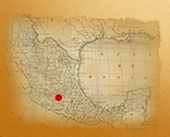
well as stature within the community. Santa Clara del Cobre is a pretty, quiet little town dedicated to copper. Walk down any street and you will hear the "chink, chink, chink" of hammer striking the metal, the soft, beautiful sound of creation.
ATZCUARO, 231 miles west of Mexico City, in the state of Michoacan was the capital of the Tarasco tribe from about A.D. 1325 to 1400. The king Tariacuri died and the Tarascan state divided into three parts that competed for domination, but together successfully repulsed Aztec attacks. The Spanish arrived in 1522 to a mostly friendly reception. When they returned in 1529 it was under Nuno de Guzman, a conquistador of legendary cruelty. Guzman's inhumanity to the indigenous people was so severe that in 1536 the Catholic church sent a bishop, Vasco de Quiroga, to restore order. He pioneered village cooperatives based on the humanitarian ideas of Sir Thomas More's Utopia, thus encouraging education and agricultural self-sufficiency in all the villages surrounding Lake Patzcuaro.
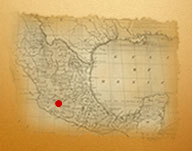
He helped each village develop its own craft. The Utopian communities declined after his death in 1565, but the crafts traditions continue to this day, rendering Patzcuaro one of the most important handicraft centers in all of Mexico.
AXACA City, capital of the state of the same name, lies 340 miles southeast of Mexico City, located in a valley surrounded by the Sierra Madre del Sur. Oaxaca City was once the center of Mixtec and Zapotec civilizations. Today it is a combination of pre-Hispanic, colonial and modern influences. Thourgh Spanish Colonial in architecture, the city remains basically Indian at heart. The combination of culture, language, food and art have created a lovely, mellow city where tourism abounds. In addition to the varied handicrafts found there, Oaxaca is famous for its traditional hand made filigree jewelry.
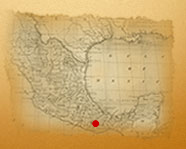
UADALAJARA, Mexico's second largest city, is located west of Mexico City and counts as its contributions to Mexican life mariachi music, sombreros, rodeos, the Mexican Hat dance and tequila. Today vast industries render the city noisy and polluted, while full of beautiful museums, galleries, historic buildings and culture. Although not mineral rich, the area developed with assistance of the church which fostered small industry and handicraft traditions.

A mere 80 miles east of Mexico City lies Puebla, Mexico's fourth largest city, in the state of the same name. Surrounded by forests, farms and dramatic snow-capped volcanoes, Puebla was founded by Spanish settlers in 1531 as the new Jerusalem The center was laid out to replicate Jerusalem with fourteen churches positioned as the stations of the cross. The city quickly grew into an important Catholic center where nearly 100 churches can be found today. Already known for pottery making before the Conquest, Talavera artisans from Toledo, Spain brought their talents to blend with those of the native artisans to create wonderful pottery. This traditon continues today and Talavera is Puebla's largest craft. However, various cities in the state of Puebla have produced many other types of handicrafts inlcuding glass, textiles, amate paper, fine furniture and
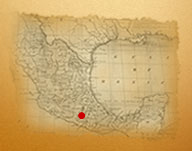
silver jewelry. The battle of Cinco de Mayo against the french invaders in 1862 occured in Puebla and mole sauce originated here in the the kitchen of the Santa Rosa Convent.







The native people of Mexico developed great skill in design and craftsmanship over centuries.
They created to express a
deeper meaning, to honor the
gods they worshiped.
Their gods lived in the land
around them, and were part of
life every day.
Native designs were sophisticated, and modern artists learn from them to this day.

After the conquest some native craftsmen worked in the Spanish workshops. Though their skill often surpassed that of their masters they were put in the position of lowly workers, producing jewelry in the Spanish style for the Spanish overlords. Mexican jewerly is a direct result of the native interpretation of the Spanish style, and the influence of the native aesthetic on Spanish goldsmiths.

The Butterfly-
love, flickering
fire, the soul,
flowers

Mexicans
love birds!

rain,
fertility of the
soil

Gift from the waters
Filigree is an ancient method of creating jewelry using very thin metal wire, that is twisted and built up to form lacy designs. It is used in all parts of the world. The lacy, open filigree common in Mexican jewelry most likely came from the Spaniards. It is often bold and rythmical, showing the influence of the native aesthetic. The filigree of each region differs. Heavy, or round, or flat wire create different effects. You can see filigree everywhere in Mexico, not only in gold or silver, but also in iron.
Cascabeles are the little bells which hang either separately or in rows on many of the jewels. These bells were an important feature of pre-hispanic jewelry. They gave sound to the movement of the wearer. Small ones were worn in bands around the ankles or arms. The larger ones were worn on the chest, or as pendants. Today these are seldom bells but only metal drops in the shape of bells.
Mexican jewelers take inspiration from the objects that surround them in their daily life.


The methods of Spanish domination of the Mexican indigenous people often resulted in forced conversions to Catholicism, which ultimately meant that the people continued in their previous belief system. This led to indigenous religious practices being incorporated into the practices of Catholicism. Explore the story of Our Lady of Guadalupe, and Milagros, or miracles.

One of Mexico's unique contributions to devotional silver work are called milagros or miracles. When a person venerated a particular saint they would use a milagro to help that saint perform a miracle (hence the word "milagro"). There was a milagro for virtually every animal, every organ and every imaginable malady. The people will usually nail these charms onto sacred objects like crosses, pin them on the clothing of saint statues, or hang with little red ribbons or threads from alters and shrines. 'Roll over the Milagros on St. Joseph.

- Call Toll Free 1.888.780.8377
- Fax: 360.697-9916
Frequently Asked Qestions
Terms & Conditions
With thanks to:
Mary L Davis and Greta Pack authors of 'Mexican Jewelry'
+923244858668356-D Block Sabzazar
Lahore, Pakistan


